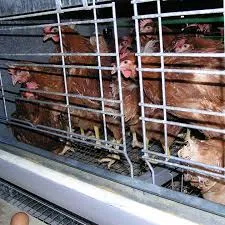High-Quality Layer Chicken Cages Available for Purchase Now
Dec . 03, 2024 17:39 Back to list
High-Quality Layer Chicken Cages Available for Purchase Now
Layer Chicken Cages for Sale A Comprehensive Guide
In the modern poultry farming industry, the utilization of layer chicken cages has become increasingly prominent. These cages are designed to optimize the production of eggs while ensuring the welfare of the chickens. For poultry farmers looking to enhance their operations or start a new venture, investing in layer chicken cages is a smart choice. In this article, we will explore the various aspects of layer chicken cages for sale, including their benefits, types, and considerations for selection.
Benefits of Layer Chicken Cages
1. Space Efficiency Layer chicken cages allow farmers to maximize the available space. By stacking cages vertically, more hens can be raised in a smaller area without compromising their comfort or productivity.
2. Enhanced Biosecurity Cages can help minimize the risk of disease transmission among birds. By keeping hens in a controlled environment, farmers can reduce direct contact with feces and other potential contaminants.
3. Improved Egg Production Caged systems often lead to higher egg production rates. The design of the cages ensures that hens have optimal access to feed, water, and light, all of which are essential for egg-laying.
4. Easier Management Layer chicken cages simplify feeding, watering, and egg collection processes. Automated systems can be integrated with cages to streamline these tasks, thus saving time and labor costs.
5. Health Monitoring With cages, it is easier to monitor the health of individual birds. Farmers can quickly identify any signs of illness or distress, allowing for timely intervention.
Types of Layer Chicken Cages
When considering layer chicken cages for sale, it is essential to understand the different types available on the market.
1. Battery Cages These are the traditional type of layer cages, where hens are housed in a series of small enclosures. While they are space-efficient, concerns regarding animal welfare have led to increased scrutiny and regulations.
layer chicken cages for sale

2. Aviary Cages Aviary systems provide hens with more space and the ability to move around, encouraging natural behaviors such as perching and nesting. These systems are often viewed as more humane and are gaining popularity in the industry.
3. Free-Range Systems Although not traditional cages, these systems allow hens to roam freely within a designated area. Farmers who prioritize animal welfare often opt for free-range systems, despite the challenges associated with managing them.
4. Enriched Cages Enriched cages combine elements of traditional battery cages and aviary systems. They provide additional space and features like perches, nesting boxes, and scratching areas, enhancing the welfare of hens while still maintaining efficiency.
Factors to Consider When Purchasing Layer Chicken Cages
1. Space Requirements Evaluate the number of hens to be housed and ensure the cages meet legal space requirements for each bird to ensure welfare standards.
2. Material Quality Choose cages made from durable materials that can withstand wear and tear. Stainless steel is often preferred for its longevity and resistance to corrosion.
3. Ventilation and Temperature Control Proper ventilation is crucial for maintaining a healthy environment. Ensure that cages allow for adequate airflow and can be adapted to seasonal temperature changes.
4. Ease of Cleaning Select cage designs that facilitate easy cleaning and maintenance. This will help in maintaining hygiene and preventing disease outbreaks.
5. Cost Consider your budget while also weighing the long-term investment potential. Higher-quality cages may have a higher initial cost but can lead to greater savings over time through increased production and reduced labor costs.
Conclusion
Layer chicken cages are a vital investment for any poultry farmer aiming to enhance productivity and ensure the well-being of their flock. With numerous options available, it is essential to choose the right type of cage that aligns with your operational goals and welfare standards. By considering factors such as space, material quality, and cleaning efficiency, farmers can make informed decisions that will benefit both their business and their chickens. As the industry continues to evolve towards more humane practices, layered cages remain a cornerstone of modern poultry management.
-
Hot Sale 24 & 18 Door Rabbit Cages - Premium Breeding Solutions
NewsJul.25,2025
-
Automatic Feeding Line System Pan Feeder Nipple Drinker - Anping County Yize Metal Products Co., Ltd.
NewsJul.21,2025
-
Automatic Feeding Line System Pan Feeder Nipple Drinker - Anping County Yize Metal Products Co., Ltd.
NewsJul.21,2025
-
Automatic Feeding Line System - Anping Yize | Precision & Nipple
NewsJul.21,2025
-
Automatic Feeding Line System - Anping Yize | Precision & Nipple
NewsJul.21,2025
-
Automatic Feeding Line System-Anping County Yize Metal Products Co., Ltd.|Efficient Feed Distribution&Customized Animal Farming Solutions
NewsJul.21,2025






